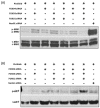Pictilisib-Induced Resistance Is Mediated through FOXO1-Dependent Activation of Receptor Tyrosine Kinases in Mucinous Colorectal Adenocarcinoma Cells
- PMID: 37569713
- PMCID: PMC10418489
- DOI: 10.3390/ijms241512331
Pictilisib-Induced Resistance Is Mediated through FOXO1-Dependent Activation of Receptor Tyrosine Kinases in Mucinous Colorectal Adenocarcinoma Cells
Abstract
The phosphatidylinositol (PI3K)/AKT/mTOR axis represents an important therapeutic target to treat human cancers. A well-described downstream target of the PI3K pathway is the forkhead box O (FOXO) transcription factor family. FOXOs have been implicated in many cellular responses, including drug-induced resistance in cancer cells. However, FOXO-dependent acute phase resistance mediated by pictilisib, a potent small molecule PI3K inhibitor (PI3Ki), has not been studied. Here, we report that pictilisib-induced adaptive resistance is regulated by the FOXO-dependent rebound activity of receptor tyrosine kinases (RTKs) in mucinous colorectal adenocarcinoma (MCA) cells. The resistance mediated by PI3K inhibition involves the nuclear localization of FOXO and the altered expression of RTKs, including ErbB2, ErbB3, EphA7, EphA10, IR, and IGF-R1 in MCA cells. Further, in the presence of FOXO siRNA, the pictilisib-induced feedback activation of RTK regulators (pERK and pAKT) was altered in MCA cells. Interestingly, the combinational treatment of pictilisib (Pi3Ki) and FOXO1i (AS1842856) synergistically reduced MCA cell viability and increased apoptosis. These results demonstrate that pictilisib used as a single agent induces acute resistance, partly through FOXO1 inhibition. Therefore, overcoming PI3Ki single-agent adaptive resistance by rational design of FOXO1 and PI3K inhibitor combinations could significantly enhance the therapeutic efficacy of PI3K-targeting drugs in MCA cells.
Keywords: FOXO; mucinous colorectal adenocarcinomas; pictilisib.
Conflict of interest statement
The authors declare no conflict of interest.
Figures






Similar articles
-
FoxO transcription factors promote AKT Ser473 phosphorylation and renal tumor growth in response to pharmacologic inhibition of the PI3K-AKT pathway.Cancer Res. 2014 Mar 15;74(6):1682-93. doi: 10.1158/0008-5472.CAN-13-1729. Epub 2014 Jan 21. Cancer Res. 2014. PMID: 24448243 Free PMC article.
-
Will PI3K pathway inhibitors be effective as single agents in patients with cancer?Oncotarget. 2011 Dec;2(12):1314-21. doi: 10.18632/oncotarget.409. Oncotarget. 2011. PMID: 22248929 Free PMC article.
-
Receptor tyrosine kinases exert dominant control over PI3K signaling in human KRAS mutant colorectal cancers.J Clin Invest. 2011 Nov;121(11):4311-21. doi: 10.1172/JCI57909. Epub 2011 Oct 10. J Clin Invest. 2011. PMID: 21985784 Free PMC article.
-
PI3K/AKT Pathway and Its Mediators in Thyroid Carcinomas.Mol Diagn Ther. 2016 Feb;20(1):13-26. doi: 10.1007/s40291-015-0175-y. Mol Diagn Ther. 2016. PMID: 26597586 Review.
-
Role of FOXO protein's abnormal activation through PI3K/AKT pathway in platinum resistance of ovarian cancer.J Obstet Gynaecol Res. 2021 Jun;47(6):1946-1957. doi: 10.1111/jog.14753. Epub 2021 Apr 7. J Obstet Gynaecol Res. 2021. PMID: 33827148 Review.
Cited by
-
Novel Therapeutic Approaches for Colorectal Cancer Treatment.Int J Mol Sci. 2024 Feb 13;25(4):2228. doi: 10.3390/ijms25042228. Int J Mol Sci. 2024. PMID: 38396903 Free PMC article.
-
The Innate Immune System Surveillance Biomarker p87 in African Americans and Caucasians with Small High-Grade Dysplastic Adenoma [SHiGDA] and Right-Sided JAK3 Colon Mutations May Explain the Presence of Multiple Cancers Revealing an Important Minority of Patients with JAK3 Mutations and Colorectal Neoplasia.Gastrointest Disord (Basel). 2024 Jun 7;6(2):497-512. doi: 10.3390/gidisord6020034. Gastrointest Disord (Basel). 2024. PMID: 39507544 Free PMC article.
-
Opposing Interplay between Nuclear Factor Erythroid 2-Related Factor 2 and Forkhead BoxO 1/3 is Responsible for Sepantronium Bromide's Poor Efficacy and Resistance in Cancer cells: Opportunity for Combination Therapy in Triple Negative Breast Cancer.ACS Pharmacol Transl Sci. 2024 Apr 29;7(5):1237-1251. doi: 10.1021/acsptsci.3c00279. eCollection 2024 May 10. ACS Pharmacol Transl Sci. 2024. PMID: 38751638 Free PMC article.
-
Experimental Verification of Erchen Decoction Plus Huiyanzhuyu Decoction in the Treatment of Laryngeal Squamous Cell Carcinoma Based on Network Pharmacology.Integr Cancer Ther. 2024 Jan-Dec;23:15347354241259182. doi: 10.1177/15347354241259182. Integr Cancer Ther. 2024. PMID: 38845538 Free PMC article.
References
MeSH terms
Substances
Grants and funding
LinkOut - more resources
Full Text Sources
Medical
Research Materials
Miscellaneous

